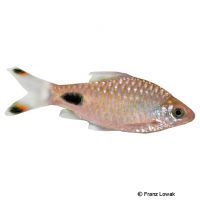Mascara Barb (Dawkinsia assimilis)
| Mascara Barb Dawkinsia assimilis | |
|---|---|
| Name | Mascara Barb |
| Name Lat. | Dawkinsia assimilis |
| Synonym | Systomus assimilis |
| Family | Carps |
| Family lat. | Cyprinidae |
| Order | Carps |
| Order lat. | Cypriniformes |
| Origin | India |
| Habitat | Streams, rivers |
| Diet | Omnivore |
| pH | 6.0-7.0 |
| Behavior | Peaceful |
| Keeping | Group |
| Care Level | Moderate |
| Reproduction | Egg scatterer |
| Breeding | Moderately difficult |
| Life Span | 4-6 years |
| Protection | No |
| Metric Units | |
| Size | 10-12 cm |
| Temperature | 20-25 °C |
| Hardness | 2-10 °dH |
| Aquarium | ~ 240 l |
| US Units | |
| Size | 4"-5" |
| Temperature | 68-77 °F |
| Hardness | 36-178 ppm |
| Aquarium | ~ 65 gal |
Distribution and habitat
The range of the Mascaras is in southwestern India, where they occur exclusively (endemically) in the Western Ghats (Nethravati River, Bhavani River, Chalakudy River). They live both in clear, flowing rivers and streams with stony bottoms, and in slow-flowing waters with muddy bottoms.
Maintenance
The aquarium should have a robust border planting, with hiding and retreat possibilities (roots, stones) and offer sufficient swimming space. A dark, sandy substrate, some shaded light (floating plants) and soft, slightly acidic water with a weak current is ideal.
No ammonia, ammonium and nitrite should be detectable, the nitrate value should not exceed 100 mg/l. To ensure the water quality and oxygen content, a filter and heater adapted to the aquarium size is required, as well as lighting for the species-appropriate day-night rhythm of the animals.
Diet
In nature they feed on worms, insects, small crustaceans and detritus. The food offer consists of live food, which is accepted without problems also in frozen form, supplemented with high-quality dry food (flakes, granules). Especially daphnia, artemia and red mosquito larvae must not be missing. In addition, they also regularly need vegetable food, such as pureed leafy and wild vegetables, algae leaves or dry food with high vegetable content (spirulina, kelp).
A regular and varied diet promotes health and prevents deficiency symptoms. Only feed as much as is eaten in a few minutes.
Behaviour and compatibility
At least 5, but preferably more of these lively fish should be kept together. They can be socialized well with robust fish that are not too small, such as other barbs or loaches. Males occasionally threaten each other without serious altercations. Basically, only compatible fish species with similar demands on water condition and water temperature should be socialized
Sex dimorphism
The males are more intensely colored than the females and they show distinct color patterns. The more inconspicuous females are usually somewhat larger and rounder. During the spawning season, small bumps can be seen on the head of the male.
Reproduction and breeding
They are free spawners that do not engage in brood care. The male usually swims around (drifts) the female in the early morning, which spawns among fine-feathered plants. The parents are spawn predators and should be relocated. The larvae hatch after about 24-48 hours and swim freely after a week
Juveniles must be fed several times a day with special rearing food (dust food, microworms). In community tanks breeding is hardly possible, because the spawn is easy prey.
Important
They can be distinguished from the similar looking Puntius filamentosus by their underslung mouth and long barbels on the upper jaw.
The well-being of the fish should be checked regularly. Temperature should be checked daily, pH, hardness and nitrate levels should be checked at least every 14 days. Regular partial water changes are recommended, even if the contaminant level has not yet reached the upper limit. Sudden changes in water quality should be avoided. Newly introduced fish must be accustomed slowly to the water in the aquarium.
Further literature can be found in your pet store.
References
Text: petdata; Image: Franz Lowak
Source: BMELV (1998): Tierschutzgutachten - Haltung von Zierfischen (Süßwasser); ENGELMANN (2005): Zootierhaltung - Tiere in menschlicher Obhut: Fische, Verlag Harri Deutsch
- Gemäß § 21 Abs. 5 Tierschutzgesetz idgF
